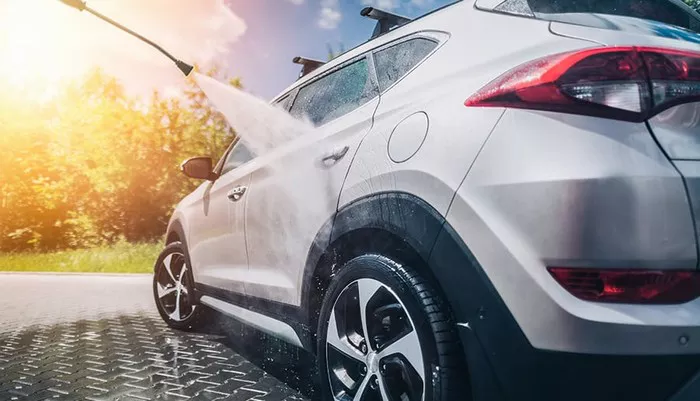Pressure washing your car can be an efficient and effective way to maintain its appearance and value. The benefits of pressure washing a car include removing dirt, grime, and contaminants that can damage the paint and bodywork over time. This method saves time and water compared to traditional hand washing, providing a thorough clean in a fraction of the time. However, using the correct pressure setting, measured in PSI (pounds per square inch), is crucial to avoid damaging your car’s paintwork.
Incorrect use of a pressure washer can lead to paint chips, scratches, or even dents, which can be costly to repair. Therefore, understanding the appropriate PSI levels and techniques for pressure washing your car is essential for maintaining its pristine condition.
Understanding PSI and GPM
What is PSI?
PSI stands for pounds per square inch and is a measure of the pressure exerted by the water coming out of the pressure washer. It indicates how powerful the water jet will be. Higher PSI levels mean more forceful water jets, which can be effective for removing tough grime and dirt but also pose a higher risk of damaging surfaces, including car paint.
See also: Pressure Washers at Walmart
Introducing GPM
GPM, or gallons per minute, measures the flow rate of water from the pressure washer. It indicates how much water is being delivered over a period of time. While PSI determines the force of the water, GPM affects the cleaning efficiency. Higher GPM means more water is being used to wash away dirt and debris, making the cleaning process faster. The combination of PSI and GPM determines the overall cleaning power of a pressure washer.
Safe PSI Levels for Car Washing
Recommended PSI Range
For washing a car, the recommended PSI range is between 1200 and 2200 PSI. This range is powerful enough to remove dirt and grime effectively without causing damage to the paintwork.
Why Higher PSI Isn’t Better
Higher PSI might seem appealing for quicker cleaning, but it increases the risk of damaging the car’s paint and even the underlying metal. High-pressure jets can strip away protective clear coats, lead to scratches, or dent thin metal surfaces. Therefore, it’s crucial to stick within the recommended PSI range to ensure your car remains in excellent condition.
Factors Affecting Safe PSI Use
Nozzle Type and Spray Angle
The type of nozzle and the spray angle significantly impact the safety and effectiveness of pressure washing. Nozzles with wider spray angles (such as 25 to 40 degrees) distribute the pressure over a larger area, reducing the risk of damage. Narrower angles (such as 0 to 15 degrees) concentrate the pressure on a small area, which can be too intense for car surfaces.
Maintaining a Safe Distance
Maintaining a safe distance between the pressure washer nozzle and the car’s surface is essential. A distance of about 12 to 24 inches is typically recommended. Getting too close can increase the impact pressure, risking damage to the paint, while staying too far may reduce the cleaning effectiveness.
Tips for Safe Pressure Washing
Start with Low PSI
Begin with the lowest PSI setting on your pressure washer and gradually increase it if necessary. This cautious approach helps you gauge the appropriate pressure level without immediately risking damage to your car.
Use a Wide Spray Nozzle
Opt for a wide spray nozzle, ideally with a 25 to 40-degree angle, to evenly distribute the water pressure. This reduces the likelihood of concentrated pressure points that can harm the paint.
Pre-Wash and Soap Application
Pre-washing the car with a gentle stream of water to remove loose dirt and debris is a good practice. Follow this with the application of car soap using a foam cannon or a low-pressure nozzle. Let the soap sit for a few minutes to loosen the grime, then rinse off using the pressure washer.
See also: Pressure Washer Lifespan
Conclusion
To safely pressure wash your car, it is crucial to use the appropriate PSI range, typically between 1200 and 2200 PSI. Higher PSI levels can cause significant damage to your car’s paint and body. Factors such as the type of nozzle and maintaining a safe distance play vital roles in ensuring a safe and effective wash.
Always start with a low PSI setting and gradually increase if needed, use a wide spray nozzle, and pre-wash the car for optimal results. Additionally, consulting your car’s manual for specific paint care instructions can help maintain its appearance and value.
FAQs
Q1: Is a higher GPM important for car washing?
A1: While a higher GPM (gallons per minute) can enhance the cleaning process by delivering more water, it is not as critical as using the correct PSI. For car washing, a balance between adequate PSI and GPM is essential for effective and safe cleaning.
Q2: Can I use a pressure washer on my windows?
A2: Yes, you can use a pressure washer on car windows, but with caution. Use a lower PSI setting and a wide spray nozzle to avoid cracking or damaging the glass. Always maintain a safe distance from the windows to ensure safety.
Disclaimer
Before using a pressure washer, always consult the manufacturer’s manual for proper operation and safety guidelines. Each pressure washer model may have specific instructions and limitations that are crucial for safe use.

